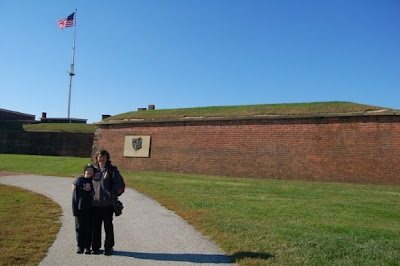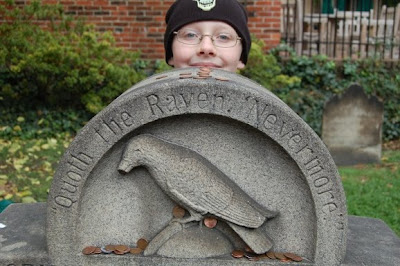
Talon Arch . . .



Ice, ice baby







Saturday, November 6:
On Saturday morning we went to Fort McHenry National Monument and Historic Shrine which is famous as the spot that inspired the "Star-Spangled Banner." We took part in a ranger-led flag talk which taught us the importance of Ft. McHenry and the U.S. flag. Did you know that the Star-Spangled Banner had 15 stars and 15 stripes, representing the first 15 states and the 15th was Kentucky? Merkin reminds me that sixty-four percent of all the Americans killed in the War of 1812 were from Kentucky while they made up only 4.6 percent of the troops! After the flag talk, we toured the ramparts of the fort as well as several buildings. Unbelievably, there were only four deaths from the 27-hour bombardment.









Sunday, November 7:
As we left Baltimore, we stopped by Church Hospital where Edgar Allan Poe died. Then we went to The Horse You Came In On Saloon at Fells Point to see where Poe was last seen drinking (supposedly).


On our long drive back, we stopped at the Chesapeake & Ohio Canal National Historical Park. The C&O Canal was the B&O railroad's rival. They started construction on the same day and are both out of use now, but the railroad lasted longer. I was disappointed that they only had a small section of the canal preserved at that site. In the yard of the C&O Canal museum there was a WWII re-enactment encampment with men dressed as soldiers, airmen, sailors, and even a few Germans, including Sgt. Schultz. It was unexpected, but I'm glad I saw it. We kept very busy on our trip, but it was fun. I especially liked every historical connection.


Prelude to Poe: Last Thursday we went to the Frazier Museum for a “Nevermore: An Evening with Edgar Allan Poe” which was a staging of several of Poe’s writings accompanied by period music. My favorite story was “The Tell-tale Heart” because you felt like you were listening to the murderer talk about what he did. It was like the book in many ways; that’s another reason I liked it. It was a good prelude for our trip to Baltimore because Poe lived, died and is buried in Baltimore.
Wednesday, November 3:
Our trip to Baltimore started when Dr. J. had a conference, so Merkin and I just tagged along. On the way there, we stopped at the Civil War battle of Monocacy which saved Washington, D.C. from being attacked by confederates. The Union commander at Monocacy was Lew Wallace who later wrote Ben Hur.
Then we flew like the Raven to Baltimore just in time to eat dinner at Annabelle Lee’s, a Poe-themed tavern, where they served drinks like “Masque of the Red Death,” “Descent into the Maelstrom,” and “Ulalame.” Merkin chose a beer called “The Raven.”


We went to the Maryland Science Museum. There we saw a good exhibit about dinosaurs and talked to a person cleaning dinosaur bones. There was also a presentation about inertia which helped me remember several facts. I will list them here: objects at rest will stay at rest until acted upon by an outside force; objects in motion will stay in motion unless acted upon by an outside force.
Baltimore is home to the American Visionary Art Museum (AVAM) which is the odds and ends of self-taught artists—and I do mean odd. The buildings were works of art in themselves. Much of the buildings are covered (and filled) with mosaics that Mane would love. In the mosaics we noted little figurines of presidents. In the yard there was a bus and a giant egg covered with mosaics. There was a giant bird made out of old parts and a giant nest. Inside we found a Lusitania made completely out of toothpicks, and it was several feet long.
One of my favorites was an Abe Lincoln statue made out of wax. The gift shop was just as crazy as the museum: from rubber chickens to George bush voodoo dolls and all sorts of other items you wouldn’t find anywhere else. The person at the counter taught me several neat magic tricks.


Friday, November 5:
The next stop was the B&O Railroad Museum which has one the biggest collection of American trains. The Baltimore and Ohio (B&O) was the first commercial railroad in America. We saw one of the largest engines ever made: the 1604 Allegheny. Only two of these trains still exist. We also went on a train ride along the first mile or so of B & O track. This was my favorite place on our trip.


That afternoon was our scary tour of Baltimore including two cemeteries and the neighborhood of the Poe house. We went to the Poe house when it was supposed to be open, but it was closed! At least we got to see the outside. We visited Poe’s grave at Westminster Burying Ground. When Poe died, he was buried in one part of the cemetery with his father. Later he was moved to a spot near the main gate. Merkin says it’s a perfect graveyard for Poe. It’s full of ancient-looking above-ground crypts and there are even catacombs under the church.



 John Wilkes Booth
John Wilkes Booth